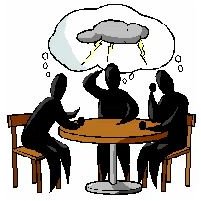Free Training Brainstorming Games You Can Use Now
Introduction
Training brainstorming games give participants a break from instructional lectures. Facilitators encourage people to express creative ideas in response to a challenge. By establishing a few ground rules, such as requiring each person to show respect to all other participants, the facilitator enables everyone to contribute. Additionally, visually documenting the results of brainstorming activities as concept maps allows training participants to produce a reference tool for use back on the job. Brainstorming tends to be a fun, productive activity that is useful as a team building technique as well.
Ice-Breaker Game
Using a brainstorming game such as an ice-breaker activity provides an engaging and interactive start to a training session. Usually, the facilitator writes a problem statement, ideally related to the instructional topic, on a whiteboard or flip chart and asks each participant to introduce himself with an idea for solving the problem. The facilitator or a designated participant takes notes on the whiteboard, flip chart or computer. At the completion of the introductory session, the facilitator calls for a vote on the most creative idea. The winner receives a small prize or a certificate. This activity can be repeated at the end of the training session as well.
Envelope Game
A facilitator divides training participants into teams of four. The facilitator then distributes envelopes containing blank index cards, markers and a challenge written on the front. Challenges should be specific to the instructional objectives, such as customer service problems, technical issues or interpersonal conflict scenarios. For five minutes, each team debates how to solve the problem, documenting ideas by writing them on the index cards. Once the brainstorming session completes, the teams swap envelopes. For the next five minutes, the teams evaluate how useful the brainstorming ideas of the other team are by scoring each card out of 10 points. The total score gets written on the outside of the envelope. The team with the highest total score wins the game.
Jeopardy Game
In this game based on the popular television game show, the facilitator writes sets of phases that reflect the reverse of the desired state, related to the instructional content, in columns on a whiteboard or flip chart. Points are associated with each phrase. Reverse brainstorming allows participants to examine problems from a different point of view. For example, a phrase related to customer service might be “customer dissatisfaction.” Participants each have a chance to select a phrase and pose a question that might be the cause, such “What results from delivering the wrong spare part?” The participant, who comes up the most plausible possibilities, as judged by the facilitator, wins the game. By analyzing the results, the participants can typically list the desired effects more easily.
Conclusion
Training brainstorming games tend to be an effective use of time because people develop ideas triggered by other people’s contributions. Brainstorming games provide a competitive atmosphere to spur people’s creative thinking. Brainstorming during training sessions permits participants to develop critical thinking skills, collaborate with other people solving similar problems and refine theories related to problem resolution. Effective facilitators ensure that everyone has an opportunity to contribute their perspective and provide tools such as markers and flip charts or templates to capture the ideas so participants can use their learning back on the job.
References and Image Credit
Thiagarajan, Sivasailam. Thiagi’s 100 favorite games . San Francisco: Pfeiffer, 2006.
Image Credit: Wikimedia Commons - Agripolare
